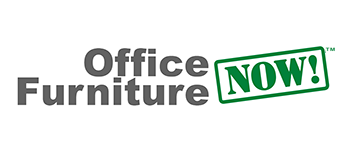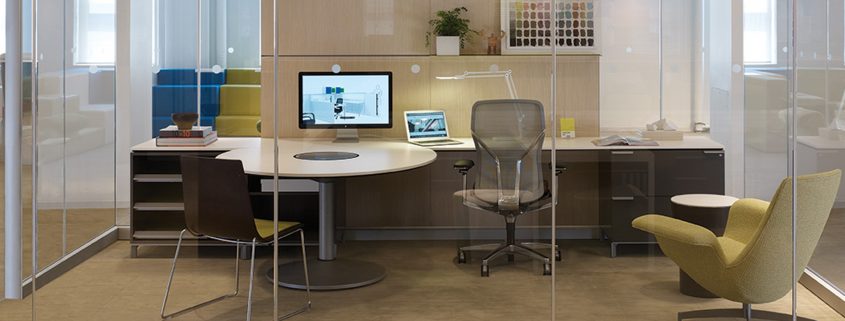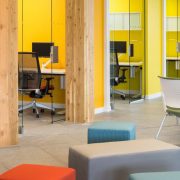Is The Open Plan Office Destroying Workplace Culture?
What if your office suddenly went from private to out in the open? What would be the biggest change you could imagine from the open office experience? How would you prepare and adapt your tasks? This begs the question: is the open plan office destroying workplace culture? A hundred questions and scenarios could begin coursing through your brain about coping in such an exposed situation where productivity is still paramount. In its effort for progress, it is becoming quite clear that the collaborative culture may have derailed itself with distraction.
Open concept office design is the new normal in the workplace today. It is quick to start up and manipulate, can readily accommodate staff fluctuations and is easier to break down and take with you when you outgrow the office space. The shift from cubicles to open plan benching systems is at its zenith. Industry communicators, like Google, Yahoo, eBay, and Facebook, have led this change. Goldman Sachs even took it to Wall Street. While most of these workplaces are very well designed, technologically savvy, dazzling with amenities and primed for collaboration….there’s one thing missing: a quiet place to think. So how can something so beautifully designed, open and airy become so dizzy, oppressive and distracting?
TOO MUCH OF A GOOD THING
Open office plans are designed to encourage better communication and chance encounters, which should, in turn, lead to more creativity, teamwork and the breakdown of silos among departments. But the steady stream of conversations, phone calls and the daily interactions of getting things done can become overwhelming when the barriers come down. Not only are your coworkers able to see everything going on in your workspace, your employer can also see and hear everything you are doing. Believing this keeps them in the loop, many employers are in fact getting a false sense of productivity. Most workers are quick to point out that the distractions are disengaging and plentiful:
- Increased noise from phone calls and casual conversations impedes focus and concentration
- Distractions create a lot of backtracking and regrouping and impede productivity
- Germs are spread more readily and neighboring workers are more likely to get sick
- Lack of privacy for personal or business calls, increases stress and reduces morale
Researchers are now in agreement that inconvenient interruptions, increased stress, conflict and high staff turnover have been a by-product of the open plan office. Shorter calls and more superficial discussions may be counterproductive to the collaborative effort and the transparency of your company mission. Even illness is on the rise, because if the sniffles are going around….everybody is going to get it! It has now been suggested that traditional office environments may increase wellbeing by over 30% and productivity by up to 15%. There are distinct advantages and disadvantages to both traditional and open office designs. But the bottom line is: if working in plain view isn’t working for your team, your turnover is going to rise and your productivity is going to decline.
ALTERING THE PARADIGM
The industry communicators like Google and Facebook that have been at the forefront of transparency and open office collaboration, have recognized this and are now bridging the privacy gaps in the open office plan with innovative design solutions. Nearly half of the surveyed workers in open offices said the lack of sound privacy was a significant problem for them and more than 30% complained about the lack of visual privacy. When Facebook CEO Mark Zuckerberg enlisted famed architect Frank Gehry to design the largest open floor plan in the world to house it’s nearly 3,000 engineers, they took this into consideration. The new office was proprietarily designed to address the environment their engineers would need to perform their jobs efficiently. Providing sufficient areas for the engineers to discuss in private and work without interruptions was part of a well-planned agenda incorporating the new buzz words of collaborative office design:
- Proximity: Providing people plenty of personal space, but facilitating traffic patterns that result in “run-ins” at shared resources like restrooms, entrances/exits, snack rooms, elevators, etc.
- Privacy: Designing work stations that offer visual and acoustic privacy, where workers can always see if someone is approaching
- Permission: Corporate culture dictates what is “permissible”. Providing clarity about the degree of acceptable informal socializing and what is acceptable or not when it comes to interrupting someone who is working.
Fostering the right kind of interactions in any office setting is a design decision. It is a collaborative effort. We answer questions like this all the time in our office and for our customers. Considering the solution from all angles will guide you to the right corporate culture for your team. Being heard in the collaborative design process gives your employees a chance to participate in your mission and brand on an inclusive level. As thought leaders and business owners all know, change is inevitable. Adapting to the needs your office culture is one thing you can control through a well-planned office environment.
For more inspiration visit us on Facebook, Pinterest and Twitter! Jump over to Instagram and see what Mr. Green is up to!
 MEET JULIE SHEAFFER: Julie can provide you with answers and furnishing choices to fit your collaborative workspace needs. Her combined product expertise and application knowledge can help you create an environment that will meet and exceed the needs of your team. Julie can help you find the right furniture for your home office, Contact Julie at 888-910-3769 x129 or julie@officefurniturenow.com.
MEET JULIE SHEAFFER: Julie can provide you with answers and furnishing choices to fit your collaborative workspace needs. Her combined product expertise and application knowledge can help you create an environment that will meet and exceed the needs of your team. Julie can help you find the right furniture for your home office, Contact Julie at 888-910-3769 x129 or julie@officefurniturenow.com.




